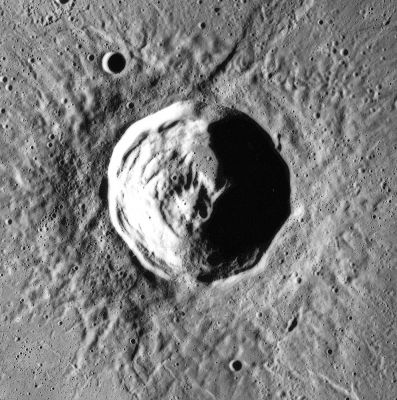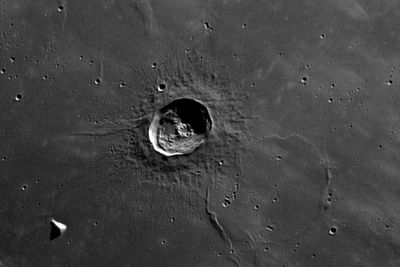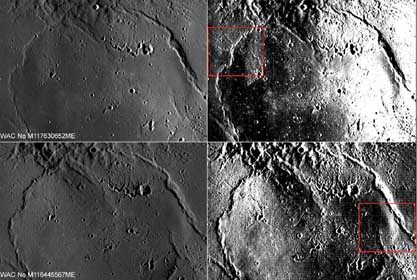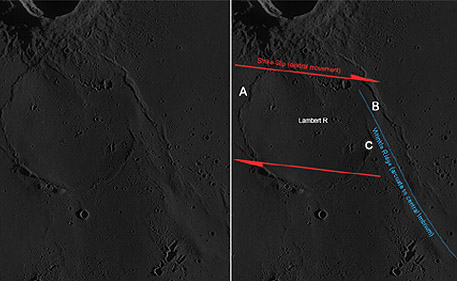Difference between revisions of "Lambert"
(Created page with "<div id="content_view" class="wiki" style="display: block"> =Lambert= {| class="wiki_table" | Lat: 25.8°N, Long: 21.0°W, Diam: 30 km, Depth: 2.6 km, [/R%C3%BCkl%2020 Rü...") |
|||
| Line 30: | Line 30: | ||
* '''Lambert Gamma''', a triangular hill at 26°30' North/ 18°30' West, is also known as "'''Mons [/Undest Undest]'''" and appears in several Apollo photos. | * '''Lambert Gamma''', a triangular hill at 26°30' North/ 18°30' West, is also known as "'''Mons [/Undest Undest]'''" and appears in several Apollo photos. | ||
* '''Lambert Delta''', a hillock at 27°10' North/ 17°10' West, is depicted on [http://www.lpi.usra.edu/resources/apollo/frame/?AS15-81-11028 AS15-81-11028]. <span class="membersnap">- [http://www.wikispaces.com/user/view/DannyCaes [[Image:DannyCaes-lg.jpg|16px|DannyCaes]]] [http://www.wikispaces.com/user/view/DannyCaes DannyCaes] <small>Dec 18, 2007</small></span> | * '''Lambert Delta''', a hillock at 27°10' North/ 17°10' West, is depicted on [http://www.lpi.usra.edu/resources/apollo/frame/?AS15-81-11028 AS15-81-11028]. <span class="membersnap">- [http://www.wikispaces.com/user/view/DannyCaes [[Image:DannyCaes-lg.jpg|16px|DannyCaes]]] [http://www.wikispaces.com/user/view/DannyCaes DannyCaes] <small>Dec 18, 2007</small></span> | ||
| − | * '''The Lambert R Strike-Slip fault?:'''<br /> Image-set views of '''Lambert R''' (just south of Lambert crater) under different lighting conditions. As pointed out by Chuck Wood in his [http://lpod.wikispaces.com/May%2030%2C%202010 Strike-Slip] LPOD of May 30 2010, there may be possibility of a ''[/Geological%20Nomenclature%20and%20Terminology#strikeslip Strike-Slip]'' fault occurring between the northern half and southern half of this 'buried' crater.<br /> [http://the-moon. | + | * '''The Lambert R Strike-Slip fault?:'''<br /> Image-set views of '''Lambert R''' (just south of Lambert crater) under different lighting conditions. As pointed out by Chuck Wood in his [http://lpod.wikispaces.com/May%2030%2C%202010 Strike-Slip] LPOD of May 30 2010, there may be possibility of a ''[/Geological%20Nomenclature%20and%20Terminology#strikeslip Strike-Slip]'' fault occurring between the northern half and southern half of this 'buried' crater.<br /> [http://the-moon.us/wiki/file/detail/LambertR-strike-slip.jpg [[Image:LambertR-strike-slip-small.jpg|LambertR-strike-slip-small.jpg]]][http://the-moon.us/wiki/file/detail/LambertR-wrinkle.jpg [[Image:LambertR-wrinkle-small2.jpg|LambertR-wrinkle-small2.jpg]]]<br /> '''LEFT SET (set of four images):''' ''Top left'' - westerly-lighted view of '''Lambert R''', ''bottom left'' - easterly-lighted). ''Top right'' and ''bottom right'' - same two views as in left-side images, but highly-contrasted (Photoshoped) to show what appears to be a differerence in elevation - from the lighting effects - in surface-heights (red boxes) around regions where the possible fault occurred.<br /> '''RIGHT SET (set of two):''' ''Left'' - larger view of the '''Lambert R''' region, ''right'' - same view (annotated). From the larger view perspective of '''Lambert R''''s surrounds , the wrinkle ridge just south-eastwards of this possible '''buried crater''' may have influenced its eastern sector. The apparent '''break''' at '''B''' (shown in the annotated image) suggests some lateral faulting, however, on closer inspection the '''buried''' part of the rim between the '''break''' looks continuous down onto '''C'''. So, if that is correct, there may not be a lateral fault here at all, and the other apparent '''break''' at '''A''' (again, shown in the annotated image) may just be that - a '''break''' in the '''buried''' western rim of the crater (due to possible slumping early on its history). Images used have WAC Nos. ([http://wms.lroc.asu.edu/lroc/view_lroc/LRO-L-LROC-2-EDR-V1.0/M117630652ME M117630652ME] and [http://wms.lroc.asu.edu/lroc/view_lroc/LRO-L-LROC-2-EDR-V1.0/M116445567ME M116445567ME]) respectively, and were taken from the ''[http://lroc.sese.asu.edu/index.html LROC]'' series of images. They were calibtrated using the [http://ltvt.wikispaces.com/Utility%20Programs#WAC_Viewer LROC_WAC_Previewer] software. ''Click images for larger views.''<span class="membersnap">- [http://www.wikispaces.com/user/view/JohnMoore2 [[Image:JohnMoore2-lg.jpg|16px|JohnMoore2]]] [http://www.wikispaces.com/user/view/JohnMoore2 JohnMoore2]</span> |
<br /> | <br /> | ||
==Nomenclature== | ==Nomenclature== | ||
| Line 38: | Line 38: | ||
<br /> | <br /> | ||
==LPOD Articles== | ==LPOD Articles== | ||
| − | [http:// | + | [http://www2.lpod.org/wiki/February_18,_2005 Lambert R] [http://www2.lpod.org/wiki/August_18,_2006 Lambert region]<br /> <br /> |
==Bibliography== | ==Bibliography== | ||
Revision as of 19:22, 11 April 2018
Contents
Lambert
|
Lat: 25.8°N, Long: 21.0°W, Diam: 30 km, Depth: 2.6 km, [/R%C3%BCkl%2020 Rükl 20], [/Stratigraphy Eratosthenian] |


Left: Apollo 15 AS15-M-1695 The 4-km crater to the northwest of Lambert is Lambert A. Right: Wes Higgins, Lambert and the 55-km ghost crater Lambert R (note that this image is mirror-reversed with north at about a 45° angle to the upper left). Portions of [/Dorsum%20Zirkel Dorsum Zirkel] (at top) and [/Dorsa%20Stille Dorsa Stille] (at left = east) are also visible.
Table of Contents
Images
LPOD Photo Gallery Lunar Orbiter Images Apollo Images
- Apollo 15's Fairchild camera frames AS15-M-2590, 2591, 2592 and 2593 show Lambert during high solar illumination (without the typical pitch black shadows). Lambert is the pronounced crater in the foreground (near the upper margin).
- Lambert Gamma, a.k.a. the LTO's "Mons Undest" (Undset) was captured on several of Apollo 17's orbital ITEK-panoramic frames, such as AS17-P-3071 (scroll to the right).
Research Apollo photos: Danny Caes
Maps
([/LAC%20zone LAC zone] 40A3) LAC map Geologic map LTO map
Description
Description: Elger
([/IAU%20Directions IAU Directions]) LAMBERT.--A ring-plain, 17 miles in diameter, presenting many noteworthy features. The crest of its border stands about 2,000 feet above the [/Mare%20Imbrium Mare Imbrium], and more than double this height above the interior. The wall is prominently terraced both within and without; the outer slope on the E. exhibiting at sunrise a nearly continuous valley running round it. When near the morning terminator, the region on the N. is seen to be traversed by some very remarkable ridges and markings; one cutting across the N. wall appears to represent a "fault." On the S. is a large polygonal enclosure formed by low ridges. On the E., towards [/Timocharis Timocharis], is a brilliant mountain 3,000 feet high, a beautiful little object under a low sun.
Description: Wikipedia
Additional Information
- The central peak system of Lambert shows a most peculiar "wavy" arrangement (four or five "waves"). Fortunately, this system is running east-west, with the "waves" ideally positioned to show us the sunlit and shadowed slopes of them. - DannyCaes DannyCaes Aug 24, 2014
- Depth data from [/Kurt%20Fisher%20crater%20depths Kurt Fisher database]
- Pike, 1976: 2.6 km
- Westfall, 2000: 2.6 km
- Viscardy, 1985: 2.69 km
- Cherrington, 1969: 2.4 km
- Thermal anomaly crater, implying youthful age - [/Moore%20et%20al%2C%201980 Moore et al, 1980]
- Included in [/ALPO%20list%20of%20bright%20ray%20craters ALPO list of bright ray craters]
- At 24°30' North/ 18° West (east-southeast of Lambert), is a short rille-like depression which is described and depicted in NASA SP-362 APOLLO OVER THE MOON; A VIEW FROM ORBIT, Chapter 7: Unusual Features (Part 1), Figure 225. See also Chapter 4: The Maria (Part 1), Figure 67. - DannyCaes DannyCaes Dec 18, 2007
- Lambert Gamma, a triangular hill at 26°30' North/ 18°30' West, is also known as "Mons [/Undest Undest]" and appears in several Apollo photos.
- Lambert Delta, a hillock at 27°10' North/ 17°10' West, is depicted on AS15-81-11028. - DannyCaes DannyCaes Dec 18, 2007
- The Lambert R Strike-Slip fault?:
Image-set views of Lambert R (just south of Lambert crater) under different lighting conditions. As pointed out by Chuck Wood in his Strike-Slip LPOD of May 30 2010, there may be possibility of a [/Geological%20Nomenclature%20and%20Terminology#strikeslip Strike-Slip] fault occurring between the northern half and southern half of this 'buried' crater.


LEFT SET (set of four images): Top left - westerly-lighted view of Lambert R, bottom left - easterly-lighted). Top right and bottom right - same two views as in left-side images, but highly-contrasted (Photoshoped) to show what appears to be a differerence in elevation - from the lighting effects - in surface-heights (red boxes) around regions where the possible fault occurred.
RIGHT SET (set of two): Left - larger view of the Lambert R region, right - same view (annotated). From the larger view perspective of Lambert R's surrounds , the wrinkle ridge just south-eastwards of this possible buried crater may have influenced its eastern sector. The apparent break at B (shown in the annotated image) suggests some lateral faulting, however, on closer inspection the buried part of the rim between the break looks continuous down onto C. So, if that is correct, there may not be a lateral fault here at all, and the other apparent break at A (again, shown in the annotated image) may just be that - a break in the buried western rim of the crater (due to possible slumping early on its history). Images used have WAC Nos. (M117630652ME and M116445567ME) respectively, and were taken from the LROC series of images. They were calibtrated using the LROC_WAC_Previewer software. Click images for larger views.- JohnMoore2 JohnMoore2
Nomenclature
- Named for Johann Heinrich Lambert (August 26, 1728 – September 25, 1777), a German mathematician, physicist and astronomer. The first practical hygrometer and photometer were invented by Lambert, as well as the map projections that bear his name. In 1760, he published a book on light reflection in Latin, in which the word [/albedo%20feature albedo] was introduced. In 1761, he hypothesized that the stars near the sun were part of a system (solar system) which travelled together through the Milky Way, and that there were many such groupings (planetary systems) throughout the galaxy. Lambert was also one of the first (contemporaneous with [/T.%20Mayer Tobias Mayer]) to accurately measure the positions of lunar features, publishing at least three lunar maps ([/Whitaker Whitaker], pp. 83-86).
- According to [/Whitaker Whitaker] (p. 218), this name was introduced by [/Schr%C3%B6ter Schröter].
LPOD Articles
Bibliography
- Lambert, Lambert R, and Lambert Gamma ("Mons Undest"):
- APOLLO OVER THE MOON; A VIEW FROM ORBIT, Chapter 4: The Maria (Part 1), Figure 67.
- Lambert R:
- AOTM, Chapter 4: The Maria (Part 3), Figure 83.
This page has been edited 1 times. The last modification was made by - tychocrater tychocrater on Jun 13, 2009 3:24 pm - afx3